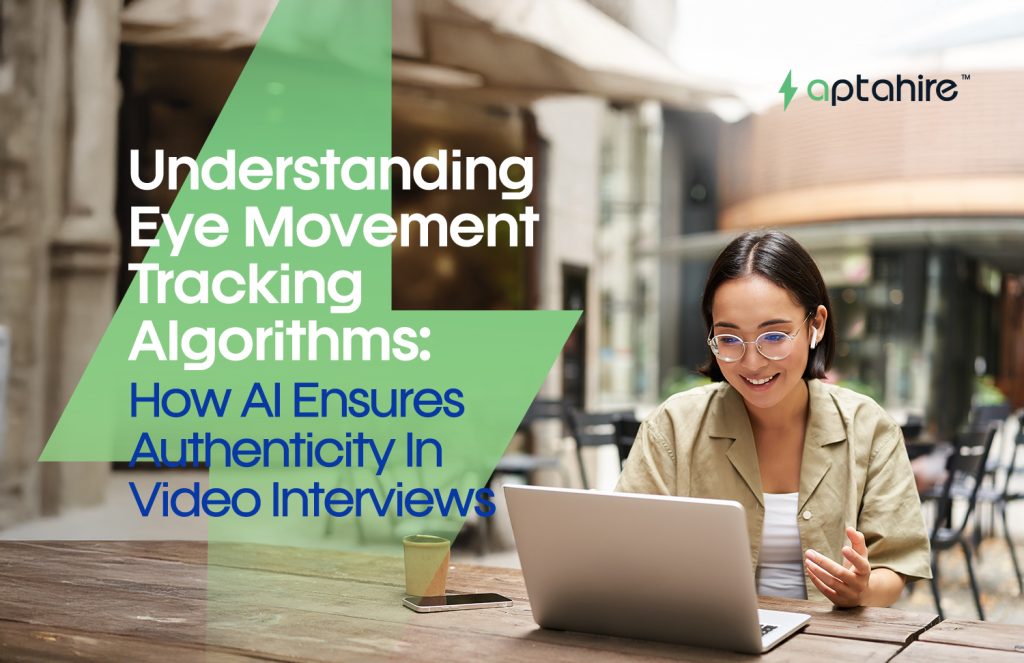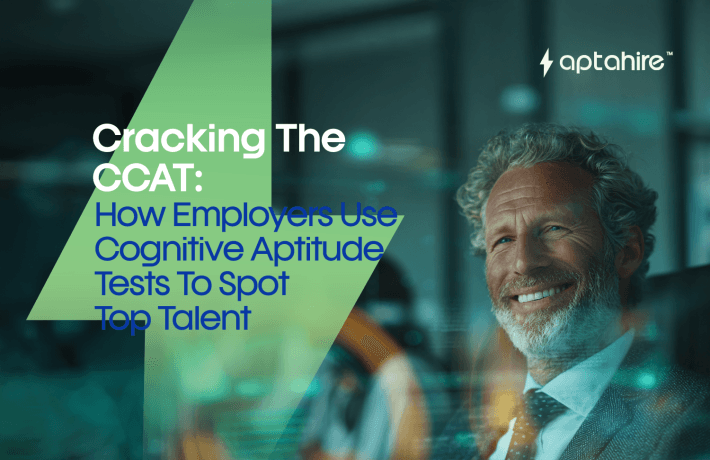Understanding Eye Movement Tracking Algorithms: How AI Ensures Authenticity in Video Interviews

Introduction: Eyes Don’t Lie, and AI Knows It
We’ve all heard the saying, “the eyes are the window to the soul.” In the world of A-powered hiring, they’re also the window to a candidate’s authenticity. Eye movement tracking, powered by sophisticated AI algorithms, is quickly becoming a key player in virtual interviews. But how exactly does this work? Can AI really analyze where and how long someone looks during a video call and tell if they’re focused, distracted, or being coached? Spoiler alert: Yes, it can, and it’s transforming how companies evaluate candidates in virtual settings.
In this blog, we’ll unpack how eye movement tracking algorithms work, why they matter in hiring, how they integrate with other AI modules, and how they ensure fairness, focus, and fraud detection.
Chapter 1: What Is Eye Movement Tracking?
Eye movement tracking refers to the process of using computer vision and AI to monitor and analyze a person’s eye position, gaze direction, blinking rate, and fixation points. In hiring interviews, it helps determine:
- Where the candidate is looking (on-screen, off-screen, down at notes?)
- How long their eyes fixate on certain areas
- Whether they’re frequently shifting their gaze (indicating possible distraction or reading cues)
- Blink rates (can suggest nervousness, anxiety, or stress)
Combined, these data points provide an emotion and attention map of the candidate throughout the session. It’s like giving recruiters an x-ray into the candidate’s engagement and mindset without interrupting the flow of the interview.
Chapter 2: The Algorithm Behind the Curtain
AI eye tracking is more than just mapping pupils. It involves multiple components:
- Face Detection: The algorithm first identifies the face within the video frame.
- Eye Localization: Then, it detects the eyes and eyelids using facial landmarks.
- Pupil Detection: Advanced techniques like infrared light or image contrast analysis pinpoint the pupil’s location.
- Gaze Estimation: Using the relative position of pupils, eyelids, and head tilt, the system estimates gaze direction.
- Behavior Analysis: Over time, it tracks eye movement patterns to assess consistency, focus, and authenticity.
Some systems use deep learning models like CNNs (Convolutional Neural Networks) or LSTMs (Long Short-Term Memory networks) trained on massive datasets to improve accuracy in diverse lighting and background conditions. These models learn patterns from thousands of facial expressions and gaze behaviors to create accurate, real-time analysis without interrupting the interview.
Chapter 3: Use Cases in AI Hiring
So, how does all this science apply to your typical Zoom-style interview?
- Detecting Distraction: If a candidate consistently looks away from the screen or their gaze is all over the place, the AI might flag this as a distraction. That doesn’t mean they’re unfit, but it gives recruiters insight into how engaged the person is.
- Preventing Coaching or Cheating: Eye tracking can detect if someone keeps glancing to the side where a helper might be stationed or a cheat sheet might be taped. It adds a layer of fraud protection to virtual interviews.
- Assessing Confidence and Comfort: Confident candidates tend to hold their gaze more steadily. AI can pick up on longer fixations and reduced rapid eye movement to indicate self-assurance or composure.
- Detecting Reading Patterns: Some candidates might be reading answers. AI can spot left-to-right eye motions that resemble reading and correlate them with potential scripted responses.
- Adaptive Interviewing: Some platforms even adapt follow-up questions in real time based on detected behaviors, e.g., asking clarifying questions when gaze behavior suggests uncertainty.
Chapter 4: The Human-AI Collaboration
Let’s be clear, eye tracking AI is not the hiring manager. It doesn’t reject candidates based on blinking too much. Rather, it provides behavioral insights that recruiters can use in context.
For example, someone might be looking away frequently not because they’re cheating, but because they’re nervous, shy, or neurodivergent. Human reviewers interpret these signals and make the final call, ensuring fairness and empathy remain core to the process.
AI acts as a smart assistant, helping humans make better decisions, not removing them from the equation.
Chapter 5: Accuracy, Limitations & Bias
No AI tool is perfect. Some limitations of eye tracking include:
- Camera quality: Poor webcams reduce accuracy.
- Lighting: Uneven lighting affects pupil detection.
- Cultural Differences: In some cultures, direct eye contact is less common and may not indicate dishonesty.
- Neurodivergence: People with ADHD, autism, or anxiety may have atypical eye movement patterns.
That’s why ethical platforms combine AI output with manual review and offer candidates full disclosure and consent protocols. It’s essential to create inclusive systems that work for a wide range of human behavior.
Chapter 6: Ethical Considerations & Consent
Any use of biometric analysis must come with transparency. Candidates should know:
- That eye movement tracking is being used
- What the data is used for
- How long it is stored
- That it won’t be the only factor in hiring decisions
Recruiters and AI providers must comply with privacy laws like GDPR and ensure that their algorithms are tested for fairness across demographics. Ethical AI isn’t optional, it’s foundational.
Transparency not only protects companies legally but also builds trust with candidates. A good candidate experience begins with informed consent.
Chapter 7: Benefits of Eye Tracking in Hiring
- Enhances Interview Integrity: Makes it harder to game the system.
- Promotes Fairness: Identifies non-verbal cues often missed in video calls.
- Saves Time: Helps recruiters zero in on top candidates faster.
- Adds Behavioral Context: Not just what they say, but how they say it.
- Supports Better Hiring Outcomes: Helps predict candidate fit beyond resumes and rehearsed answers.
Chapter 8: Beyond Hiring – Other Applications
The same technology has huge potential in:
- Education: Tracking student attention in online learning to improve engagement.
- Healthcare: Diagnosing neurological conditions like Parkinson’s, ADHD, or concussions.
- UX Research: Understanding where users focus on a screen to improve product design.
- Gaming and AR/VR: Creating responsive environments based on user attention.
Conclusion: The Future Is in Sight
Eye movement tracking isn’t about policing candidates. It’s about understanding them better. When used responsibly, it adds nuance, insight, and fairness to the hiring process. As virtual interviews become the norm, these AI-powered tools are helping companies make smarter, more informed, and more human-centric decisions.
Because in the end, the best interviews don’t just listen to what you say, they see how you show up.
Want to Know More? Let us know if you’d like to explore:
- A demo of AI hiring software with eye-tracking features
- Guidelines on ethically deploying AI in recruitment
- Candidate communication templates for transparency
The future of hiring is watching, with purpose, precision, and empathy.
FAQs
1. How does AI eye tracking work?
AI eye tracking works by using computer vision and machine learning algorithms to detect, monitor, and interpret the position and movement of a person’s eyes in real time. A camera (usually a webcam or infrared sensor) captures facial data, and AI analyzes the direction of gaze, blinking, and movement patterns to determine where a person is looking, for how long, and what their eye behavior may indicate (e.g., attention, distraction, stress).
2. What is the algorithm for eye detection?
The most common algorithms used for eye detection include:
- Haar Cascades: A machine learning object detection algorithm used in OpenCV for detecting eyes and faces.
- Convolutional Neural Networks (CNNs): Deep learning models trained to detect and classify eye regions and gaze direction from facial landmarks.
- Dlib + Facial Landmark Detection: A technique that identifies key facial points (like eye corners and pupil centers) for gaze estimation.
- Pupil Detection Algorithms: Methods that use contrast, shape, and reflection to pinpoint the pupil, often enhanced with infrared light for accuracy.
3. What is the purpose of eye tracking technology?
The primary purpose of eye tracking is to understand what a person is looking at and how they interact visually with their environment. In specific contexts, it helps:
- Hiring: Detect coaching or distraction during interviews.
- Marketing: Measure ad or UI engagement.
- Healthcare: Diagnose conditions like ADHD, autism, or neurological disorders.
- Education: Monitor student focus during online learning.
- Gaming & AR/VR: Enable gaze-based control and interactions.
4. What is the eye tracking method in research?
In research, eye tracking typically uses remote or wearable devices to collect precise data on:
- Fixations: Where and how long the eyes stay in one spot.
- Saccades: Rapid movements between fixations.
- Scanpaths: The sequence of fixations and saccades.
Researchers analyze these patterns to study behavior, cognitive load, decision-making, visual attention, and more.
5. What is the principle of eye tracking?
Eye tracking is based on the principle of corneal reflection and pupil center detection. By projecting infrared light onto the eye and capturing the reflection from the cornea and retina, sensors can triangulate the point of gaze. In AI-based systems, gaze direction is calculated using the geometry of the eyes and head position derived from facial landmarks.
6. Which sensor is used for eye detection?
The most common sensors used for eye detection are:
- Infrared (IR) Cameras: Ideal for low-light environments and accurate pupil detection through corneal reflection.
- RGB Cameras: Standard webcams used in computer vision applications, though less accurate than IR in low-light or high-glare conditions.
- Depth Sensors (like in AR/VR): Track 3D eye movements with higher accuracy.
7. What is the principle of eye movement?
The principle of eye movement is that the eyes move to bring objects of interest into the fovea, the central part of the retina where visual acuity is highest. Eye movements are classified into:
- Saccades: Quick, simultaneous movements of both eyes in the same direction.
- Fixations: Brief pauses where visual information is acquired.
- Smooth Pursuit: Slow tracking of moving objects.
- Vergence Movements: Eyes move in opposite directions to maintain focus on an object as it moves closer or farther.
8. What are the two types of eye tracking devices?
The two main types are:
- Remote Eye Trackers: Stationary devices (usually under the monitor) that track eye movements using cameras and sensors without any physical contact.
- Wearable Eye Trackers: Glasses or headsets equipped with cameras and sensors that track the eyes and head position, allowing for mobile or real-world tracking.



